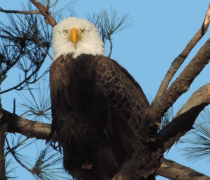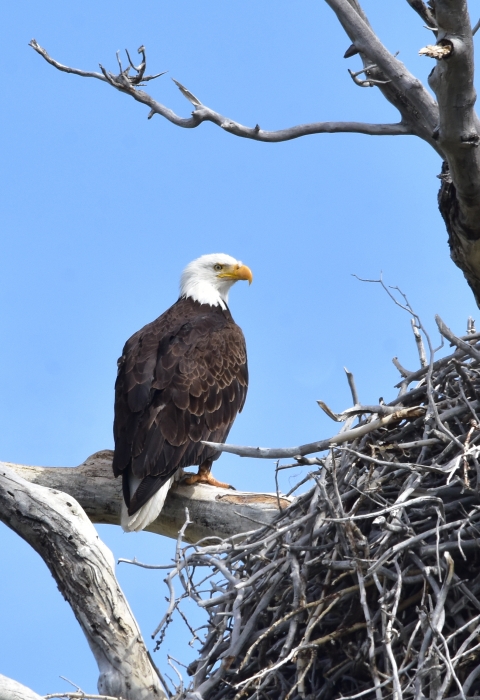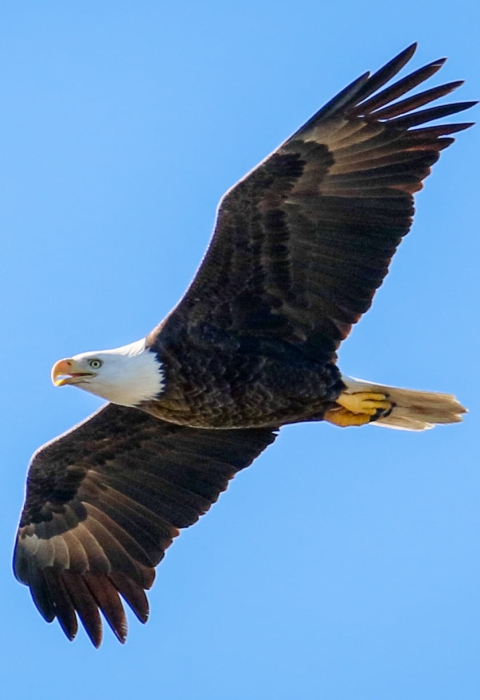
Effective April 12, 2024, the Service is implementing revised regulations for the incidental take of bald and golden eagles. Please visit our Eagle Management page for information on implementation of these regulations.
Overview
The bald eagle is an Endangered Species Act success story. In the mid-1900s, our national symbol was in danger of extinction throughout most of its range. Bald eagles were decimated by habitat destruction and degradation, as well as illegal shooting and the contamination of their food source by the insecticide dichlorodiphenyltrichloroethane, known as DDT.
Habitat protection afforded by the Endangered Species Act, the federal government’s banning of DDT, and conservation actions taken by the American public have helped bald eagles make a remarkable recovery. Bald eagle sightings are now a common occurrence in many parts of the country.
When America adopted the bald eagle as the national symbol in 1782, anecdotal accounts stated that the country may have had as many as 100,000 nesting eagles. The first major decline of the species probably began in the mid to late 1800s, coinciding with the decline of waterfowl, shorebirds and other prey.
Although they primarily eat fish and carrion, bald eagles used to be considered marauders that preyed on chickens, lambs and domestic livestock. Consequently, the large raptors were shot in an effort to eliminate a perceived threat. Coupled with the loss of nesting habitat, bald eagle populations declined.
In 1940, noting that the species was threatened with extinction, Congress passed the Bald Eagle Protection Act, which prohibited killing, selling or possessing the species. A 1962 amendment added the golden eagle, and the law became the Bald and Golden Eagle Protection Act.
Shortly after World War II, DDT was hailed as a new pesticide to control mosquitoes and other insects. However, DDT and its residues, washed into nearby waterways, where aquatic plants and fish absorbed it. Bald eagles, in turn, were poisoned with DDT when they ate the contaminated fish. The chemical interfered with the ability of the birds to produce strong eggshells. As a result, their eggs had shells so thin that they often broke during incubation or otherwise failed to hatch. Other pesticides related to DDT are suspected to have caused increased mortality, in addition to DDT’s harmful effects on reproduction. By 1963, with only 417 nesting pairs of bald eagles known to exist, the species was in danger of extinction.
In 1967, the Secretary of Interior listed bald eagles south of the 40th parallel under the Endangered Species Preservation Act. In 1972, as the dangers of DDT became known - in large part due to Rachel Carson’s book Silent Spring - the Environmental Protection Agency took the historic and, at the time, controversial step of banning the use of DDT and some related pesticides in the United States.
Following enactment of the Endangered Species Act, we listed the species in 1978 as endangered throughout the lower 48 states, except in Michigan, Minnesota, Oregon, Washington and Wisconsin, where it was designated as threatened. The species was not listed as threatened or endangered in Alaska because populations there have remained robust.
Listing the species as endangered provided the springboard for working with our partners to accelerate the pace of recovery through captive breeding programs, reintroduction efforts, law enforcement and nest site protection during the breeding season.
In July 1995, we announced that bald eagles in the lower 48 states had recovered to the point where those populations previously considered endangered could be reclassified to the less critical category of threatened.
Then in 2007, we estimated there were at least 9,789 nesting pairs of bald eagles in the contiguous United States. Bald eagles staged a remarkable population rebound and recovered to the point that they no longer needed the protection of the Endangered Species Act. On June 28, 2007, we announced the recovery of our nation’s symbol and removal from the list of threatened and endangered species.
Bald eagle populations throughout the country have continued to rise with an estimated population of 72,434 individuals, including 30,548 breeding pairs, in 2009 in the lower 48 states. Estimates for the bald eagle population in the lower 48 states, based on data from 2018 to 2019, total 316,700 individuals, including 71,467 breeding pairs.
The recovery of the bald eagle is one of the most well-known conservation success stories of all time. We continue to work with our partners in state and federal agencies, tribes, nongovernment organizations and private landowners to ensure that our nation’s symbol flourishes.
Even though bald eagles were delisted from the Endangered Species Act in August 2007, because their populations recovered sufficiently, bald eagles are still protected under the Migratory Bird Treaty Act and the Bald and Golden Eagle Protection Act. Both laws prohibit killing, selling, or otherwise harming eagles, their nests or eggs.
Scientific Name
Identification Numbers
Characteristics
Behavior
Bald eagles can be seen soaring high above, flying around water bodies, perched in trees or on towers and standing on rocks or the ground. They are visual predators and hunt both while flying and from perches. Bald eagles can even be seen in the water, diving for their fish and waterfowl prey or swimming with their catch with a rowing motion of their wings, if they’re too wet to fly directly off the water!
Although bald eagles maintain breeding territories, it is common to see them roosting with other bald eagles when they are not breeding. These communal roosts generate a lot of interaction among the eagles and are a good place to hear them vocalizing. Bald eagles have even exhibited behaviors that look like play, passing sticks in the air to each other and picking up and manipulating plastic bottles.
Life Cycle
Bald eagles can live up to about 30 years in the wild, and even longer in captivity.
Most bald eagles are capable of breeding at 4 or 5 years of age, but in dense populations they may not start breeding until much older. Bald eagles mate for life, but if an individual in the pair dies, the survivor will accept a new mate.
Eagle pairs usually choose the tops of large trees to build nests, however bald eagle nests have also been found on cliffs, the ground and even on human-made structures like power poles and communication towers. When nesting in trees, they generally select the tallest trees with limbs strong enough to support their large, heavy nests. Nests are generally 4 to 5 feet wide and 2 to 4 feet deep. These nests can reach 10 feet across and can weigh thousands of pounds. The largest recorded bald eagle nest, located in St. Petersburg, Florida, was 9.5 feet in diameter, 20 feet deep and weighed almost 6,000 pounds! Eagle nests are constructed with large sticks, and may be lined with moss, grass, plant stalks, lichens, seaweed or sod. Pairs will often use and enlarge the same nest each year, but bald eagles may also have one or more alternate nests within their breeding territory. Nest sites typically include at least one perch with a clear view of a water body for foraging, but bald eagles nests are increasingly being found away from large water bodies.
The eagles may travel great distances during various phases of their lives and non-breeding seasons, but usually return to nest and breed within 100 miles of the place where they were raised. Throughout much of their range, bald eagles usually breed in early spring with breeding lasting into the summer. However, in hot climates, like Louisiana and Florida, bald eagles nest during the winter. It is also more common in southern areas for bald eagles to attempt to re-nest if their first nest fails before hatching chicks.
Breeding bald eagles typically lay one to three eggs once a year, with the eggs hatching after about 35 days. The young eagles, often called eaglets, are flying within 3 months of age. They will continue to use their nest as a home base, where their parents continue to care for them for an additional four to six weeks. After about six weeks, the young eagles disperse out into the world on their own. Eaglets can have high rates of death due to disease, lack of food, bad weather or dangers associated with humans, like collision with cars or power lines. Recent studies show that approximately 70% of eaglets survive their first year of life.
Bald eagles in northern latitudes generally migrate south in the winter, then return to northerly breeding grounds in late winter and early spring. Some migration patterns in the western United States are tied to salmon runs and salmon population fluctuations. Bald eagles tend to migrate mid-day, when thermals are strongest. Adult eagles tend to take more direct migration routes than juveniles.
Food
Bald eagles are opportunistic feeders, with fish being a staple food. They will also feed on waterfowl, shorebirds, waterbirds, turtles, rabbits, snakes, small animals and carrion. Because eagles are visual hunters, they typically locate prey from a conspicuous perch, or soaring flight, and then swoop down and strike. They are known to scavenge on dead fish and animals, and are also notorious food thieves, stealing the caught prey from other eagles, mammals and other birds of prey.
Physical Characteristics
Bald eagles are large, powerful birds. Females may have a wingspan of up to 8 feet. Male eagles are smaller than females, and may have a wingspan of up to 6 feet.
The well-known white head and white tail of bald eagles, with a brown body, is the plumage of a mature adult. Bald eagles generally attain adult plumage by 5 years of age. Until bald eagles reach 4 to 5 years of age, they have mottled brown and white feathers all over their bodies, and slowly develop their distinctive white head and tail as they age. Bald eagles also slowly develop their light eyes and bright yellow bills; juvenile eagles initially have dark eyes and bills, that lighten as they reach adulthood. Bald eagles have yellow legs and only the tops of their legs have feathers.
Females may weigh as much as 14 pounds. Males may weigh as much as 10 pounds. Bald eagles in the northern part of their range grow larger than those in the southern parts of their range. Bald eagles in Alaska have been known to reach 16 pounds.
The call of a bald eagle may not be what you might expect from such a large raptor. Bald eagle calls have been described as weak in volume and like a snickering laugh. The calls consist of seven or eight notes described as, “ki-ki-ki-ki-ki-ki-ker."
Similar Species
If plumage is not clearly seen, bald eagles can be confused with golden eagles. Young bald eagles less than 5 years old, do not yet have a fully white head and white tail. They also are variably molted brown and white, so are juveniles easily confused with golden eagles. Eagles can also be confused with turkey vultures or black vultures. If size is misjudged, they can also be confused with larger hawk species like as red-tailed hawks.
Habitat
Bald eagles require a good food base, perching areas and nesting sites. Traditionally, bald eagles were found nesting near rivers, lakes and marshes. Their habitat can include estuaries, large lakes, reservoirs, rivers and some seacoasts. They’re also increasingly found in drier areas that are farther from water sources such as farmland and urban and suburban habitat.
In winter, the birds congregate in large numbers near open water in tall trees that they use for spotting prey. These trees also provide night roosts for sheltering. These areas can be found below artificial dams or river tributaries that will keep larger channels open. Winter roost sites may be used all winter or only for short periods of time when other food sources are not available.
Land covered by evergreen trees in cool, northern latitudes. Also called taiga.
Geography
The import, and or, export of bald eagles, or their parts, nests, or eggs is prohibited by law.
The bald eagle is truly an all-American bird and is the only eagle that is solely native to North America. Its historic range was from Alaska and Canada, across the contiguous United States and down to northern Mexico.
Timeline
Explore the information available for this taxon's timeline. You can select an event on the timeline to view more information, or cycle through the content available in the carousel below.
48 Items
